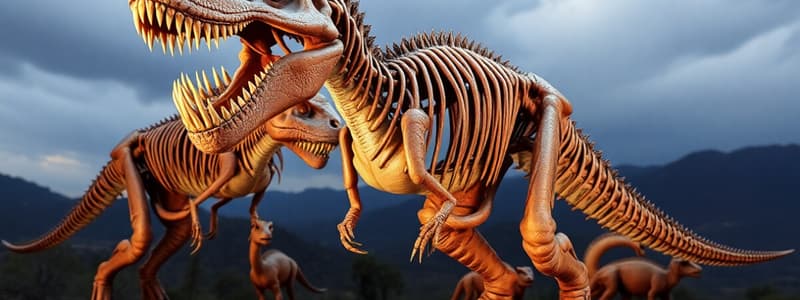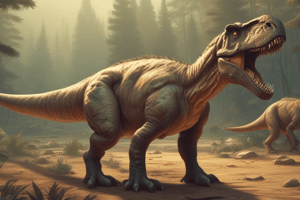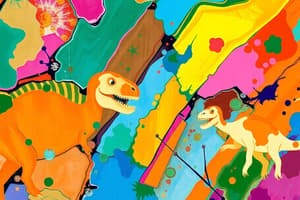Podcast
Questions and Answers
What do scientists use to determine the correct sequence of sedimentary rock layers?
What do scientists use to determine the correct sequence of sedimentary rock layers?
- The fossils found within the layers (correct)
- The age of the rocks themselves
- The color of the layers
- The location of the layers
What is suggested about organisms in the context of sedimentary layers?
What is suggested about organisms in the context of sedimentary layers?
- They completely disappear and reappear across layers
- They may survive from one time period to the next (correct)
- They can only be found in one specific layer
- They evolve significantly in each layer
How are the sedimentary layers arranged in relation to their age?
How are the sedimentary layers arranged in relation to their age?
- All layers are considered the same age
- Randomly arranged regardless of age
- Oldest at the bottom and youngest at the top (correct)
- Youngest at the bottom and oldest at the top
What can be inferred by comparing sedimentary layers?
What can be inferred by comparing sedimentary layers?
Which question might scientists explore when examining layers of rock?
Which question might scientists explore when examining layers of rock?
What does scientific knowledge do over time?
What does scientific knowledge do over time?
Which of the following tools has been used by paleontologists for over 150 years?
Which of the following tools has been used by paleontologists for over 150 years?
How do paleontologists often revise their understanding of ancient animals?
How do paleontologists often revise their understanding of ancient animals?
What role do advanced imaging technologies play in paleontology?
What role do advanced imaging technologies play in paleontology?
What kind of funding contributed to the film Dinosaurs Alive?
What kind of funding contributed to the film Dinosaurs Alive?
Which of the following is NOT a modern tool used by paleontologists?
Which of the following is NOT a modern tool used by paleontologists?
What is the primary focus of the educational themes in Dinosaurs Alive?
What is the primary focus of the educational themes in Dinosaurs Alive?
How do paleontologists use GPS in their work?
How do paleontologists use GPS in their work?
What is a characteristic feature of the Coelophysis?
What is a characteristic feature of the Coelophysis?
How does the bird's furcula, or wishbone, orient in relation to the body?
How does the bird's furcula, or wishbone, orient in relation to the body?
What can affect how animals behave according to their environment?
What can affect how animals behave according to their environment?
Which behavior is likely observed in birds when in groups?
Which behavior is likely observed in birds when in groups?
Which of the following is true about the findings of dinosaur fossils?
Which of the following is true about the findings of dinosaur fossils?
What is the approximate weight of the heaviest dinosaurs, like Argentinosaurus?
What is the approximate weight of the heaviest dinosaurs, like Argentinosaurus?
What does the pubis bone of the Coelophysis do?
What does the pubis bone of the Coelophysis do?
What method is suggested to collect good data on bird behavior?
What method is suggested to collect good data on bird behavior?
What major Earth events occurred during the Permian period?
What major Earth events occurred during the Permian period?
Which period is characterized by extensive volcanic activity?
Which period is characterized by extensive volcanic activity?
What was the climate like during the Paleozoic era?
What was the climate like during the Paleozoic era?
Which organism group became extinct during the Paleozoic era?
Which organism group became extinct during the Paleozoic era?
What is the oldest geological period listed?
What is the oldest geological period listed?
What is the first step in creating a lifelike dinosaur drawing?
What is the first step in creating a lifelike dinosaur drawing?
Which of the following steps involves making shadows in dinosaur illustrations?
Which of the following steps involves making shadows in dinosaur illustrations?
During which period did the first true plants flourish?
During which period did the first true plants flourish?
What is one of the main features that allowed dinosaurs to inhabit a variety of environments?
What is one of the main features that allowed dinosaurs to inhabit a variety of environments?
Which dinosaur size comparison is mentioned in the content?
Which dinosaur size comparison is mentioned in the content?
What do fossils help scientists understand about dinosaurs?
What do fossils help scientists understand about dinosaurs?
Which period is represented by layer D?
Which period is represented by layer D?
Which activity allows students to analyze geological history alongside fossils?
Which activity allows students to analyze geological history alongside fossils?
Which organisms are present in layer A?
Which organisms are present in layer A?
How do students create a timeline of Earth's history?
How do students create a timeline of Earth's history?
What is one way students infer dinosaur behavior?
What is one way students infer dinosaur behavior?
What is the oldest layer depicted in the timeline?
What is the oldest layer depicted in the timeline?
What physical features did some dinosaurs have that were used for display and defense?
What physical features did some dinosaurs have that were used for display and defense?
Which of the following organisms is NOT found in layer C?
Which of the following organisms is NOT found in layer C?
What is a common characteristic of diverse dinosaurs mentioned in the content?
What is a common characteristic of diverse dinosaurs mentioned in the content?
Which layer represents the Cretaceous Period?
Which layer represents the Cretaceous Period?
Which organism is associated with layer B in the timeline?
Which organism is associated with layer B in the timeline?
Identify the layer that contains flowering plants.
Identify the layer that contains flowering plants.
Which of the following layers contains both sharks and ammonites?
Which of the following layers contains both sharks and ammonites?
What major evolutionary event is associated with the Cretaceous Period?
What major evolutionary event is associated with the Cretaceous Period?
Which organism does NOT appear in layer B?
Which organism does NOT appear in layer B?
Flashcards
Science is an Ongoing Process
Science is an Ongoing Process
The process of scientific understanding is constantly evolving as new knowledge is discovered. Paleontologists are always finding new fossils and this leads to new understanding of ancient animals. This also means that older fossils can be re-examined with a new perspective.
Tools and Technologies for Paleontology
Tools and Technologies for Paleontology
Paleontologists use digging tools, like shovels and brushes, to find fossils. They also use compasses to navigate. They can also use advanced technology like GPS and CAT scans. Global Positioning Systems help in locating fossils and CAT scans provide detailed 3D images of fossils.
What is a Paleontologist?
What is a Paleontologist?
Paleontologists are scientists who study fossils and prehistoric life. They can be found working in museums, universities, and government agencies. They are often involved in searching for, excavating, and analyzing fossils.
What are Fossils?
What are Fossils?
Signup and view all the flashcards
How are Fossils Excavated?
How are Fossils Excavated?
Signup and view all the flashcards
What is Paleontology?
What is Paleontology?
Signup and view all the flashcards
What is 'Dinosaurs Alive!'?
What is 'Dinosaurs Alive!'?
Signup and view all the flashcards
Advanced Imaging in Paleontology
Advanced Imaging in Paleontology
Signup and view all the flashcards
Dinosaur Diversity
Dinosaur Diversity
Signup and view all the flashcards
Dinosaur Sizes
Dinosaur Sizes
Signup and view all the flashcards
Dinosaur Features
Dinosaur Features
Signup and view all the flashcards
Dinosaur Locomotion
Dinosaur Locomotion
Signup and view all the flashcards
Dinosaur Habitats
Dinosaur Habitats
Signup and view all the flashcards
Fossils and Dinosaurs
Fossils and Dinosaurs
Signup and view all the flashcards
Birds and Dinosaurs
Birds and Dinosaurs
Signup and view all the flashcards
Bird Behavior & Dinosaurs
Bird Behavior & Dinosaurs
Signup and view all the flashcards
Fossil Correlation
Fossil Correlation
Signup and view all the flashcards
Importance of Fossils
Importance of Fossils
Signup and view all the flashcards
Comparing Fossils Across Layers
Comparing Fossils Across Layers
Signup and view all the flashcards
Principle of Superposition
Principle of Superposition
Signup and view all the flashcards
Dating Rock Layers with Fossils
Dating Rock Layers with Fossils
Signup and view all the flashcards
What is the furcula?
What is the furcula?
Signup and view all the flashcards
How does the pubis bone in the Coelophysis differ from other dinosaurs?
How does the pubis bone in the Coelophysis differ from other dinosaurs?
Signup and view all the flashcards
What is a key feature of the Coelophysis's femur?
What is a key feature of the Coelophysis's femur?
Signup and view all the flashcards
How do we learn about the history of life on Earth?
How do we learn about the history of life on Earth?
Signup and view all the flashcards
How can we recognize evidence of Coelophysis movement in the rock record?
How can we recognize evidence of Coelophysis movement in the rock record?
Signup and view all the flashcards
What can you say about the size range of dinosaurs?
What can you say about the size range of dinosaurs?
Signup and view all the flashcards
Why does the Coelophysis have an S-shaped neck?
Why does the Coelophysis have an S-shaped neck?
Signup and view all the flashcards
How did the Coelophysis's hip socket allow for greater movement?
How did the Coelophysis's hip socket allow for greater movement?
Signup and view all the flashcards
Triassic Period
Triassic Period
Signup and view all the flashcards
Jurassic Period
Jurassic Period
Signup and view all the flashcards
Cretaceous Period
Cretaceous Period
Signup and view all the flashcards
Dinosaurs
Dinosaurs
Signup and view all the flashcards
Ichthyosaurs
Ichthyosaurs
Signup and view all the flashcards
Pterosaurs
Pterosaurs
Signup and view all the flashcards
Ammonites
Ammonites
Signup and view all the flashcards
Coelacanths
Coelacanths
Signup and view all the flashcards
Postosuchus
Postosuchus
Signup and view all the flashcards
Seismosaurus
Seismosaurus
Signup and view all the flashcards
Landmass Arrangement
Landmass Arrangement
Signup and view all the flashcards
Climate of a Period
Climate of a Period
Signup and view all the flashcards
Earth Events in a Period
Earth Events in a Period
Signup and view all the flashcards
Organisms of a Period
Organisms of a Period
Signup and view all the flashcards
Periods of the Paleozoic Era
Periods of the Paleozoic Era
Signup and view all the flashcards
How Artists Recreate Dinosaurs
How Artists Recreate Dinosaurs
Signup and view all the flashcards
Adding Shading to Dinosaurs
Adding Shading to Dinosaurs
Signup and view all the flashcards
Adding Details to Dinosaur Drawings
Adding Details to Dinosaur Drawings
Signup and view all the flashcards
Study Notes
Dinosaurs Alive!
- This film is a global adventure of science and discovery
- It follows paleontologists in locations like Mongolia's Gobi Desert and New Mexico
- It uses computer-generated imagery (CGI) to showcase dinosaurs
- It helps connect the film to science curriculum through key concepts
Key Concepts
- Science is an Ongoing Process: Scientific knowledge evolves with new evidence. Paleontologists constantly unearth new fossils, and discoveries can change our understanding of dinosaurs.
- Tools and Technologies Enable Discovery: Shovels, brushes and compasses and cutting-edge technologies (GPS, satellites, digital x-rays, CAT scans) are crucial for paleontologists to find and analyze fossils. These tools reveal information like fossil location, dinosaur size, and diet.
- Fossils Reveal Dinosaur Life: Fossils of bones, skin impressions, feathers, footprints, and coprolites reveal dinosaur behavior, diet, speed, and other aspects of their lives.
- Earth Has a Vast History: Scientists divide Earth's history into eras, periods that demonstrate the evolution of dinosaurs and other organisms, and how organisms have changed over time.
Dinosaurs Are Diverse
- Dinosaurs are a highly successful group of animals with a wide array of features
- They ranged from small carnivorous dinosaurs to massive herbivores
- Their diverse body features (crests, horns, and others) were used for defense and display
Birds Are Living Dinosaurs
- Dinosaurs are not extinct
- Birds are descendants of small carnivorous dinosaurs
- They survived the catastrophic extinction event that wiped out many other dinosaurs
Studying That Suits You
Use AI to generate personalized quizzes and flashcards to suit your learning preferences.




